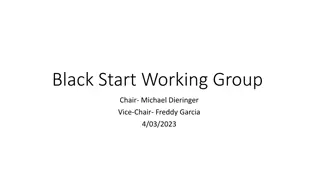Understanding the Black-Scholes Formula and Volatility Estimation
The Black-Scholes formula, developed by Dr. Fernando Diz, is a widely used model for pricing options. This formula calculates the theoretical price of an option based on various inputs, with volatility being a key factor. Volatility estimation can be done through historical or implied methods, each with its own assumptions and calculations. Historical estimation involves analyzing past returns, while implied estimation relies on current market prices. By understanding these concepts, one can better utilize the Black-Scholes formula in financial decision-making.
- Black-Scholes Formula
- Volatility Estimation
- Historical Estimation
- Implied Volatility
- Options Pricing
Download Presentation

Please find below an Image/Link to download the presentation.
The content on the website is provided AS IS for your information and personal use only. It may not be sold, licensed, or shared on other websites without obtaining consent from the author. Download presentation by click this link. If you encounter any issues during the download, it is possible that the publisher has removed the file from their server.
E N D
Presentation Transcript
THE BLACK- SCHOLES FORMULA By Dr. Fernando Diz
The Black Scholes Formula C = S N(d1) - E e-rT N(d2) where: d1 = (ln(S/E) + (r+sigma2/2)T)/sigma*sqrt(T) d2 = d1 - sigma*sqrt(T) N(d1), N(d2) = cumulative normal probabilities. sigma2 = annualized variance of the continuously compounded return on the underlying. r = continuously compounded risk-free rate.
Before we can use and understand the BS formula we need to understand its inputs. The price of the underlying asset. The exercise price. The risk-free rate. The volatility of the underlying asset. The time to expiration. Inputs of the BS Formula
Which input is unobservable? Inputs of the BS Formula THE VOLATILITY !! How do we estimate it? Historical estimation. Implied estimation.
This type of estimation ASSUMES that the volatility of the underlying asset is constant over time. Historical Historical Estimation Estimation Steps: Take a sample of say, daily cont. compounded returns: ri = ln(Si/Si-1) for i = 1, ..n.
The sampling interval can be anything, daily, weekly, monthly, etc. Calculate the variance or standard deviation of the sample. There is no minimum number of observations. A sample size of 50 is fine in most cases. Historical Historical Estimation Estimation
Annualize the variance by multiplying by 250 trading days if you used daily data, or 52 if you used weekly data, etc. If you calculated the standard deviation, annualize multiplying by sqrt(250), or sqrt(52), etc. Example in Excel. Historical Historical Estimation Estimation
This method assumes that the current option s market price reflects the volatility of the underlying asset. Implied Implied Volatility Volatility It also assumes that the pricing model that you are using is the correct model. How do you calculate it?
Steps: Implied Implied Volatility Volatility Market Price = Model(IV) where IV is the implied volatility. This involves solving a highly non-linear pricing model for a value of IV that will make the model price identical to the market price.
Implied Implied Volatility Volatility If the model is simple (Black-Scholes, Black, etc) we can simply use the goal-seek function in Excel to find the implied volatility. Example in Excel.
How to How to Calculate Calculate the Risk the Risk- -Free In the Wall Street Journal find the Treasury Bonds, Notes and Bills section. Treasury Bills will be the instrument used to calculate the risk-free rate. Free Rate Rate Choose a T-bill that matches (as much as possible) the expiration of the option under consideration.
How to How to Calculate Calculate the Risk the Risk- -Free Remember that T-Bills prices are quoted on a discount basis. Remember also that quoted discounts are based on a 360-day year, NOT 365. Free Rate Rate Remember that quoted discounts are calculated as a simple annualized interest NOT continuously compounded interest.
How to How to Calculate Calculate the Risk the Risk- -Free So, we must correct for all those factors; that is, convert the risk-free discount into a: 365 based rate. continuously compounded basis. annualize based on a continuously compounded rate. Free Rate Rate
How to How to Calculate Calculate the Risk the Risk- -Free How do we do it? Recall that the price of a zero-coupon bond (T-Bill) is equal to: B(t,T) = Face Value * exp(-r*(T-t)) Free Rate Rate Also recall that the price of the actual T-Bill is calculated as follows: T-Bill = 100 - Discount*Time to Exp/360
How to How to Calculate Calculate the Risk the Risk- -Free Using the previous two equations we can calculate the annualized continuously compounded risk-free rate. The last formula is: Free Rate Rate -ln(B(t,T)/Face Value)/(T-t) = r Excel example.
Sensitivity of the Option to Changes in Inputs DELTA. DELTA. It is the partial derivative of the model price with respect to the underlying asset. The absolute value of delta has three possible interpretations: 1. Change in the option price for a unit change in the underlying asset. Example Excel.
Sensitivity of the Option to Changes in Inputs Observe what happens to delta as we increase the asset price. It increases! Why? 2. Delta can also be interpreted as the probability of the option expiring in-the-money.
Sensitivity of the Option to Changes in Inputs How many shares of the stock would you need to short to completely offset the change in value of the option? 3. Delta is also known as the hedge ratio.























